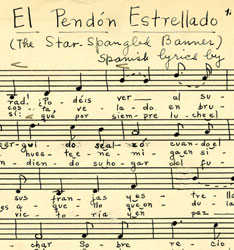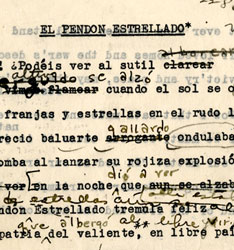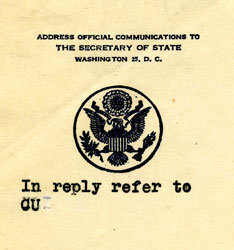
The Star-Spangled Banner
The War of 1812 inspired many patriotic acts, including the composition of the national anthem. During the war years of the 1940s, the anthem inspired the patriotism of a Peruvian immigrant composer and translator who took the time, care, and love of the United States of America to do it justice in Spanish for all of the Americas to know and understand.
In 1814 Francis Scott Key wrote “The Star-Spangled Banner” during the War of 1812, while watching the Baltimore battle of Fort McHenry. Fearing that the United States had lost the battle to the British, Key recalled that the sight of the American flag waving over the fort at “dawn’s early light” inspired him to compose the words that became the official U.S. national anthem.
It is ironic that the music Key chose belonged to the official song of the Anacreontic Society, a popular London gentlemen’s club of amateur musicians founded in the mid-18th century. The original lyrics celebrate women, wine, and entertainment.
By 1861, “The Star-Spangled Banner” had been translated into several languages. Further translations were used as a way to assimilate immigrants during the second half of the 19th century and into the beginning of the 20th. There were two Spanish versions by this time, but neither was singable.
“The Star-Spangled Banner” became the official U.S. national anthem in 1931. In 1945, the Division of Cultural Cooperation of the Department of State, in conjunction with the Music Educators National Conference, called for submissions for the translation of the song into Spanish and Portuguese, so it could be distributed throughout Latin America. What better way for the United States to share its values and patriotism with its neighbors to the south—something highly desired at the time—than through its national anthem?
Clotilde Arias took on the task, translating the lyrics so they could be sung, as required in the contract, shown here. She sent in her work; it was accepted as the most accurate and the closest to the English words. Her version still stands as the only official translation of the national anthem allowed to be sung.
The translation is extremely faithful to the original—a difficult accomplishment, for Spanish requires more words than English to convey the same message. Arias’s song is a work of art, and the manifest patriotism of a Pan-Americanist who fervently embraced the lyrics’ sentiments. More than a century removed from Francis Scott Key, and from a different country and continent, Clotilde Arias believed that people’s aspirations throughout the Americas were the same, and could be promoted and achieved through music, the arts, and cultural understanding.
La Guerra de 1812 suscitó muchos actos de patriotismo, entre ellos la composición del himno nacional. Durante los años de la Segunda Guerra Mundial, en la década de los cuarenta, el himno inspiró el patriotismo de una inmigrante peruana, compositora y traductora, quien dedicó tiempo y atención para crear una versión digna en español que todos los países de las Américas pudiesen conocer y entender.
En 1814, Francis Scott Key escribió “The Star-Spangled Banner” durante la Guerra de 1812, mientras observaba la batalla de Baltimore en el fuerte McHenry. Temeroso de que Estados Unidos hubiese perdido la batalla frente a los británicos, Key recordaba que la visión de la bandera americana ondeando en el fuerte e iluminada con “la primeras luces del alba” lo había inspirado para escribir las palabras que se convirtieron en el himno nacional oficial de Estados Unidos.
Es irónico que la música elegida por Key fuese la canción oficial de la Anacreontic Society, un conocido club londinense reservado para los hombres, fundado a mediados del siglo XVIII y cuyos miembros eran músicos aficionados. La letra original de la canción es una oda a las mujeres, al vino y al espectáculo.
En 1861, “The Star-Spangled Banner” ya se había traducido a varios idiomas. Esas traducciones se utilizaban como una manera de asimilar a los inmigrantes durante la segunda mitad del siglo XIX y a comienzos del XX. Para esa fecha ya había dos versiones en español pero ninguna podía cantarse.
En 1931, “The Star-Spangled Banner” se convirtió en el himno nacional oficial de los Estados Unidos. En 1945, la División de Cooperación Cultural del Departamento de Estado, junto con la Conferencia Nacional de Educadores de Música, solicitó propuestas para la traducción de la letra del himno al español y al portugués, a fin de poder distribuirla en todos los países de América Latina. Para Estados Unidos, que tanto anhelaba en esos años compartir sus valores y su patriotismo con sus vecinos del sur, traducir su himno nacional era una manera excelente de lograrlo.
Como era requerido en el contrato que aquí mostramos, Clotilde Arias acometió la tarea y tradujo la letra para que pudiera cantarse. Envió su trabajo y fue seleccionado como el más exacto y el más cercano a las palabras en inglés. Su versión sigue siendo, hoy en día, la única traducción oficial autorizada del himno nacional que puede cantarse.
La traducción es sumamente fiel al original, lo que es un logro difícil. La canción de Arias es una obra de arte y la manifestación del patriotismo de una panamericanista que hizo suyos con fervor los sentimientos de la letra del himno. Aunque más de un siglo la separaba del mundo de Francis Scott Key, y provenía de un país y de un continente distintos, Clotilde Arias consideraba que las aspiraciones de la gente a través de todas las Américas eran idénticas, y que podían promoverse y hacerse realidad a través de la música, las artes y el entendimiento cultural.




